Spanish Tiles in New York
18/10/10 15:44 Filed in: Special Features
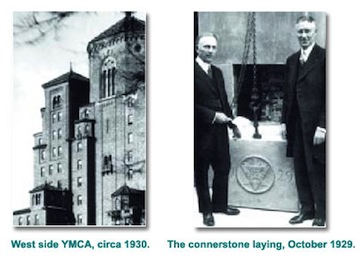
Spain’s history with the YMCA dates back to 1929, when King Alfonso XIII of Spain donated the original artistic tilework, the year the Great Depression hit America and building screeched to a halt - to achieve the Moorish interiors architect Dwight James Baum wanted to create. And although this legacy was clearly a motivation to help with the tile restoration, without the one-woman catalyst who brought the project to Spain’s attention, it ís unlikely it would have come about. So this is also the account of one woman, Caridad Lopez, Spanish expatriate and West Side Y member, who made it her business to help restore what ís considered to be an architectural masterpiece ñ the 63rd Street YMCA. Her reason, this place reminds her of home.
The YMCA is a community service organization which promotes positive values through programs that build spirit, mind and body. Caridad became a member of the Y to bolster a physical side of her ñ she wanted to learn how to swim. However, true to its mission statement, the West Side Y contributed to the health of her spirit and mind in a way she never imagined. The magnificent Spanish tile found in the Spanish Pool area where her swimming lessons were held ‘took her home’ every time she went.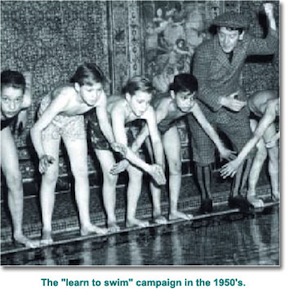 But she began to notice that although much of the tile had held up beautifully over 75 years, there were cracks and chips here and there. During a swim, Caridad met then communication director Dwight Jordan, and she commented to him about the tiles condition. Jordan shared his dilemmas with her. Apart from age, regulations, like the construction of a wheelchair-accessible ramp, were soon to destroy some of the beautiful yellow and blue Andalusian tiles. And positive, necessary improvements, like the expansion of the Youth & Teen Room, originally a cafeteria- were going to impact the Spanish tile fable motifs found there. In both cases, restoration of the authentic tiles was preferred, but costly for a not-for-profit organization like the Y. There was a capital campaign underway to renovate these areas, but the authentic reproduction of the tiles was a stumbling block. Jordan had attempted to find sources to help restore the tiles, but language and distance barriers were obstacles. So, Caridad sprung into action.
But she began to notice that although much of the tile had held up beautifully over 75 years, there were cracks and chips here and there. During a swim, Caridad met then communication director Dwight Jordan, and she commented to him about the tiles condition. Jordan shared his dilemmas with her. Apart from age, regulations, like the construction of a wheelchair-accessible ramp, were soon to destroy some of the beautiful yellow and blue Andalusian tiles. And positive, necessary improvements, like the expansion of the Youth & Teen Room, originally a cafeteria- were going to impact the Spanish tile fable motifs found there. In both cases, restoration of the authentic tiles was preferred, but costly for a not-for-profit organization like the Y. There was a capital campaign underway to renovate these areas, but the authentic reproduction of the tiles was a stumbling block. Jordan had attempted to find sources to help restore the tiles, but language and distance barriers were obstacles. So, Caridad sprung into action.
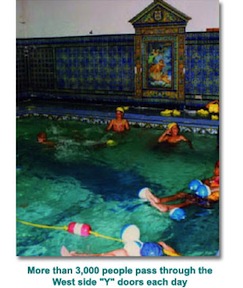 The Y Meets Tile of Spain
The Y Meets Tile of Spain
Caridad told Dwight she was taking her summer vacation in Spain. She could take samples of the tile along, to determine if they could be recreated to replace the originals.Caridad was my champion. She assured me that Spain would assist us, and would keep me hopeful by always saying “The Spanish people live to their word,” said Jordan.
While in Spain, Caridad arranged a meeting with the Spanish Ceramic Tile Manufacturers Association (ASCER). Javier Soriano, ASCER ís Director of Export Promotion, was particularly taken with Caridad’s plight and took the project under his wing. He contacted all Tile of Spain manufacturers capable of this undertaking, and after much research, Soriano found the proverbial needle in a haystack - ASCER’s member, ADEX. Long experienced in the art of hand-painted tiles, the manufacturer contributed to the restoration of Gaudiís famous Park Guell, a Unesco world heritage site, he was convinced of their ability to accurately recreate the tiles and of their charitable nature, a necessary component of the project given the Y’s limited resources.
One woman, Caridad Lopez, found a way to bring three groups, ASCER/Tile of Spain, ADEX and the West Side YMCA - together by connecting cultures, history and good cause, to renovate through exact replication these stunning tile mosaics. She was indeed the impetus and the cultural link to the restoration, translating when necessary, hosting Spanish guests at the facility and always maintaining her passion for the project.
The Tile Features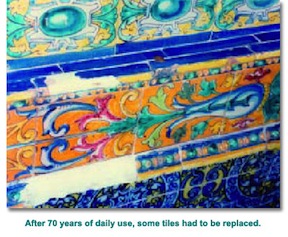
New York Cityís West Side YMCA, which was built in the late 1920’s, is a grand example of Spanish-Moorish revival architecture. It’s the largest freestanding YMCA in the world and was designed with many fanciful features, a number of which resulted from the use of tile from Spain.
The Spanish Pool is recognized internationally as an artistic treasure, featuring one of the Y’s most outstanding architectural elements, the King Neptune mosaic. ADEX has duplicated, after endless tests, over 600 hand-made, handpainted majolica tile pieces, in seven different designs and shapes, to restore this Pool. This was a huge effort, since ancient, almost lost, techniques had to be recovered to achieve the accurate replicas. For the soon-to-be Youth & Teen Room, ASCER plans a call for other Tile of Spain manufacturers to participate in that renovation, where tile’s fable motif and benches made entirely of handpainted tile need attention.
When you walk through our building, Spanish tile is everywhere,î Jordan said. 75 years ago the Spanish Government saw the value of this project and helped complete the beautiful building. Now history is repeating itself in a truly positive way, the persistence and passion of one Spanish woman is keeping these beautiful works of art alive.
We are grateful for the generous financial and artistic contributions from the country of Spain, and to Caridad for recognizing the architectural significance of this facility and making it a priority.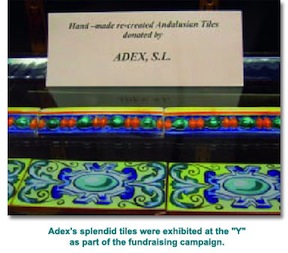
Jordan reports that in order to display to its members the support and generosity of ADEX and ASCER, an exhibit featuring the newly created tile was hosted within the facility’s grand lobby.
The pool restoration is scheduled to begin in January of 2006, after the first phase of the YMCA’s capital campaign for the renovation as a whole is finalized. YMCA administrators anticipate the completion of the project by September of 2006. The timeline for the Youth & Teen Room renovation is yet to be finalized. After 70 years of daily use, some tiles had to be replaced. More than 3,000 people pass through the west side "Y" doors each day. Adex’s splendid tiles were exhibited at the "Y" as part of the fundraising campaign.


Caridad told Dwight she was taking her summer vacation in Spain. She could take samples of the tile along, to determine if they could be recreated to replace the originals.Caridad was my champion. She assured me that Spain would assist us, and would keep me hopeful by always saying “The Spanish people live to their word,” said Jordan.
While in Spain, Caridad arranged a meeting with the Spanish Ceramic Tile Manufacturers Association (ASCER). Javier Soriano, ASCER ís Director of Export Promotion, was particularly taken with Caridad’s plight and took the project under his wing. He contacted all Tile of Spain manufacturers capable of this undertaking, and after much research, Soriano found the proverbial needle in a haystack - ASCER’s member, ADEX. Long experienced in the art of hand-painted tiles, the manufacturer contributed to the restoration of Gaudiís famous Park Guell, a Unesco world heritage site, he was convinced of their ability to accurately recreate the tiles and of their charitable nature, a necessary component of the project given the Y’s limited resources.
One woman, Caridad Lopez, found a way to bring three groups, ASCER/Tile of Spain, ADEX and the West Side YMCA - together by connecting cultures, history and good cause, to renovate through exact replication these stunning tile mosaics. She was indeed the impetus and the cultural link to the restoration, translating when necessary, hosting Spanish guests at the facility and always maintaining her passion for the project.
The Tile Features

New York Cityís West Side YMCA, which was built in the late 1920’s, is a grand example of Spanish-Moorish revival architecture. It’s the largest freestanding YMCA in the world and was designed with many fanciful features, a number of which resulted from the use of tile from Spain.
The Spanish Pool is recognized internationally as an artistic treasure, featuring one of the Y’s most outstanding architectural elements, the King Neptune mosaic. ADEX has duplicated, after endless tests, over 600 hand-made, handpainted majolica tile pieces, in seven different designs and shapes, to restore this Pool. This was a huge effort, since ancient, almost lost, techniques had to be recovered to achieve the accurate replicas. For the soon-to-be Youth & Teen Room, ASCER plans a call for other Tile of Spain manufacturers to participate in that renovation, where tile’s fable motif and benches made entirely of handpainted tile need attention.
When you walk through our building, Spanish tile is everywhere,î Jordan said. 75 years ago the Spanish Government saw the value of this project and helped complete the beautiful building. Now history is repeating itself in a truly positive way, the persistence and passion of one Spanish woman is keeping these beautiful works of art alive.
We are grateful for the generous financial and artistic contributions from the country of Spain, and to Caridad for recognizing the architectural significance of this facility and making it a priority.

Jordan reports that in order to display to its members the support and generosity of ADEX and ASCER, an exhibit featuring the newly created tile was hosted within the facility’s grand lobby.
The pool restoration is scheduled to begin in January of 2006, after the first phase of the YMCA’s capital campaign for the renovation as a whole is finalized. YMCA administrators anticipate the completion of the project by September of 2006. The timeline for the Youth & Teen Room renovation is yet to be finalized. After 70 years of daily use, some tiles had to be replaced. More than 3,000 people pass through the west side "Y" doors each day. Adex’s splendid tiles were exhibited at the "Y" as part of the fundraising campaign.
